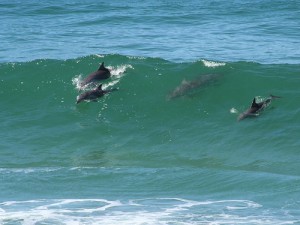
![]() Tweet The observable fact that dolphins surf is something we humans need to think about.
Tweet The observable fact that dolphins surf is something we humans need to think about.
Amory Lovins, of the Rocky Mountain Institute, coined the term “Negawatt” when he said “The cheapest unit of energy is the one you don’t have to buy.” The next cheapest, the “Nega-Fuel-Watt” is the unit of energy that doesn’t require fuel.
- Insulation Nega-Watts allow less power to heat or cool a given space.
- Solar Nega-Fuel-Watts transform photons into electricity or heat.
- Wind Nega-Fuel-Watts transform moving particles of air into electricity.
- Geothermal Nega-Fuel-Watts transform the heat of the earth into heat or electricity, or use thermal gradients to cool a space.
- Hydro Nega-Fuel-Watts transform moving particles of water – currents – to generate electricity.
| 100% Clean Energy | |
| 100 Gigawatts Wind | $300 Billion |
| 100 GW Marine Hydro | $300 B |
| 50 GW Solar | $200 B |
| 50 GW Geothermal | $200 B |
| 200 GW Equiv Efficiency | $200 B |
| A Smart Grid | $100 B |
| 500 GW or GW Equiv. | $1.3 Trillion |
I’m not sure if Lovins first public use of the term Negawatts was in Montreal in 1989 (here) or in Foreign Affairs in 1976 (abstract here), whether 22 or 35 years ago. Regardless, our current energy paradigm today is the hard fuel based path Lovins criticized 35 years ago. While we are turning away from nuclear, as documented by Mycle Schneider in the WorldWatch Report (here) – the latest radioactive nail in the radioactive coffin being the fatal explosion at a reprocessing facility in France on Monday, Sept. 12, 2011 (here) – we burn literally mountains of coal and oceans of oil and gas (According to the DoE, in 2010 we burned 1,085,281 thousand short tons of coal and 15,022 thousand short tons of coke (here). And there are consequences. We suffer oil spills, polluted water, mercury, coal mine disasters, nuclear power plant melt-downs, we fight wars …
Wind and solar don’t burn fuel. The winds blow, the sun shines, you put a widget in the path of those moving particles in the air or those photons of light and you get electricity – without greenhouse gases, radioactive wastes, toxic wastes, and it costs less. So the question is not ‘Can we meet our energy needs with clean, sustainable renewable energy technologies?” The real question are How? How Much? And How quickly?
We could do it in 25 years if we wanted to. And we should, for our children, our grandchildren, the cetaceans with whom we share our oceans, and other charismatic megafauna with whom we share our world.